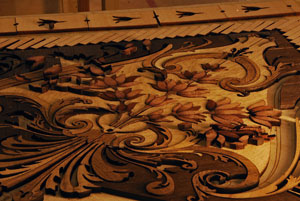
Years ago, John Yarema and his wife bought a house. “The only thing we could find that we both liked was an old one-room schoolhouse.” The house was, to put it mildly, a fixer-upper, and John and his wife, although inexperienced, worked on fixing it up themselves. “It wasn’t that nice, so anything was an improvement,” John said. It was the beginning of his journey toward working full-time with wood. 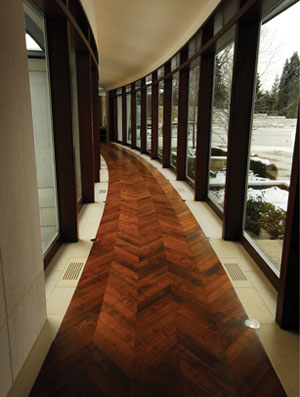 When it came time to do the floor in this old Michigan schoolhouse, John said, they thought they would just cut some logs from his family’s nearby farm. (His family owned a tool and die shop, where he used to have his summer jobs.) When the owner of a Wood-Mizer portable sawmill came out to start cutting the logs, he asked where John was planning to dry the lumber. That you had to dry it before using it was news to John. He did, however, have it dried, into an S4S product. When putting in the floor, he routed the groove, put the spline down and finished it. “It turned out well, and then my uncle said, ‘I want you to do my house.'” The uncle paid him in tools; then he did his cousin’s house … it got to the point that the supplier where John bought his wood put him on the list of recommended floor installers, and he started getting calls — from people who weren’t relatives.
When it came time to do the floor in this old Michigan schoolhouse, John said, they thought they would just cut some logs from his family’s nearby farm. (His family owned a tool and die shop, where he used to have his summer jobs.) When the owner of a Wood-Mizer portable sawmill came out to start cutting the logs, he asked where John was planning to dry the lumber. That you had to dry it before using it was news to John. He did, however, have it dried, into an S4S product. When putting in the floor, he routed the groove, put the spline down and finished it. “It turned out well, and then my uncle said, ‘I want you to do my house.'” The uncle paid him in tools; then he did his cousin’s house … it got to the point that the supplier where John bought his wood put him on the list of recommended floor installers, and he started getting calls — from people who weren’t relatives. 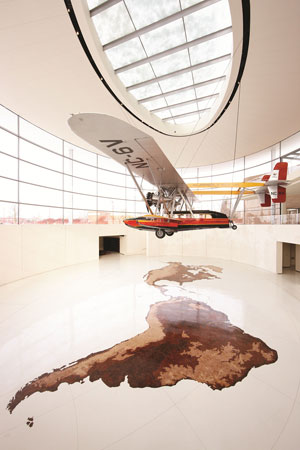 These days, John specializes in creating and installed hardwood floors — a specialty, he says, that “kind of just happened. It was like there wasn’t anyone around doing floors” when he started out. “I chose my path, and I love it,” John said. “A lot of people are just in it because their dad was a hardwood floor guy.” John is in it because he wants to work with his hands. At one point, after he’d quit his original day job as a systems engineer, his flooring business grew to the point that he hired several people. That didn’t work out so well for him. He decided, “I’ll hire somebody to walk around and do the business part of it. I want to do the work. When I was younger, I would outwork all the guys. Sixteen hours a day, I’d swing a hammer –it was fun.”
These days, John specializes in creating and installed hardwood floors — a specialty, he says, that “kind of just happened. It was like there wasn’t anyone around doing floors” when he started out. “I chose my path, and I love it,” John said. “A lot of people are just in it because their dad was a hardwood floor guy.” John is in it because he wants to work with his hands. At one point, after he’d quit his original day job as a systems engineer, his flooring business grew to the point that he hired several people. That didn’t work out so well for him. He decided, “I’ll hire somebody to walk around and do the business part of it. I want to do the work. When I was younger, I would outwork all the guys. Sixteen hours a day, I’d swing a hammer –it was fun.” 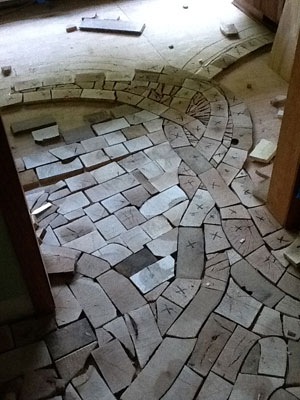 One of the projects John has worked on is reproduction of the type of parquet floor found at Versailles; another is a floor for an “off-the-grid” school near his Michigan home, utilizing “toaster blocks”: the granulated cork and sawdust that accumulates as waste material when making hardwood pallets. He and his team took the material to the school, and had the kids go through to grab the pieces they really liked and stack them in a roped-in area. “We took them back, packed up the material, dried it, and sliced it into end grain blocks. It turned out really good, and that was from material that didn’t even make it into the pallet,” John said. If John had his druthers, he said, he “would only want to source local wood that had a connection to the home, whether historically or not, or just aesthetically. It’s more fun to work, and it has tremendous value in that sense.”
One of the projects John has worked on is reproduction of the type of parquet floor found at Versailles; another is a floor for an “off-the-grid” school near his Michigan home, utilizing “toaster blocks”: the granulated cork and sawdust that accumulates as waste material when making hardwood pallets. He and his team took the material to the school, and had the kids go through to grab the pieces they really liked and stack them in a roped-in area. “We took them back, packed up the material, dried it, and sliced it into end grain blocks. It turned out really good, and that was from material that didn’t even make it into the pallet,” John said. If John had his druthers, he said, he “would only want to source local wood that had a connection to the home, whether historically or not, or just aesthetically. It’s more fun to work, and it has tremendous value in that sense.” 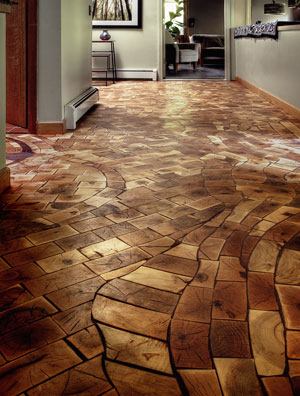 While that’s not always possible, he does try to use local and/or sustainable woods when he can. For instance, he’s used wood from logs recovered from submersion in the Great Lakes, and he uses a lot of 1/2″ Baltic birch backer boards — the chunk of wood “left over” when creating a veneer. “They’re all different shapes and sizes, but they’re high quality for inlay work,” John said. Still, “My all-time favorite is white oak,” he said. “I like it because traditionally it was ‘the’ wood.” The wood has its own influence on the projects he makes, too. “As you go through the process, it seems like everything changes,” he said. “You know what you want to do, but the wood’s kind of pushing you or guiding you. It’s fun.” Once done with a floor, he notes, he and his crew will often take the leftover material and “make something fun with it.” For John, “something fun” might be a table, or a wall mantel. For any project, he prefers “anything that makes you feel like you’re getting in over your head,” he said. “I don’t want to do the same thing twice. When you’re in over your head, interesting things happen.”
While that’s not always possible, he does try to use local and/or sustainable woods when he can. For instance, he’s used wood from logs recovered from submersion in the Great Lakes, and he uses a lot of 1/2″ Baltic birch backer boards — the chunk of wood “left over” when creating a veneer. “They’re all different shapes and sizes, but they’re high quality for inlay work,” John said. Still, “My all-time favorite is white oak,” he said. “I like it because traditionally it was ‘the’ wood.” The wood has its own influence on the projects he makes, too. “As you go through the process, it seems like everything changes,” he said. “You know what you want to do, but the wood’s kind of pushing you or guiding you. It’s fun.” Once done with a floor, he notes, he and his crew will often take the leftover material and “make something fun with it.” For John, “something fun” might be a table, or a wall mantel. For any project, he prefers “anything that makes you feel like you’re getting in over your head,” he said. “I don’t want to do the same thing twice. When you’re in over your head, interesting things happen.” 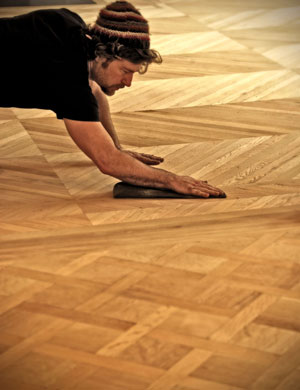 Currently, one area he’s interested in focusing on is “green” finishes. That was prompted, in part, by a a doctor’s visit when he discovered that the pulmonary part of his heart had atrophied to half its normal size. After that, John said, “It was pretty easy to say ‘I’m not gonna be around this.’ Even some water-based finishes, I would get rashes on my arms. I wanted something with bigger molecules, not sucking into my skin. If somebody wants something else, they’ll have to have somebody else put it on.” Truthfully, John says, “I don’t even like finishes. It reminds me of Star Wars, when Han Solo was encapsulated. It feels like the wood is trapped.” What he prefers, he says, is an oil and wax finish which has a patina to it. “It has the look of a handmade product.” He’s also making some of his own finishes these days, using materials like walnut husks and coffee.
Currently, one area he’s interested in focusing on is “green” finishes. That was prompted, in part, by a a doctor’s visit when he discovered that the pulmonary part of his heart had atrophied to half its normal size. After that, John said, “It was pretty easy to say ‘I’m not gonna be around this.’ Even some water-based finishes, I would get rashes on my arms. I wanted something with bigger molecules, not sucking into my skin. If somebody wants something else, they’ll have to have somebody else put it on.” Truthfully, John says, “I don’t even like finishes. It reminds me of Star Wars, when Han Solo was encapsulated. It feels like the wood is trapped.” What he prefers, he says, is an oil and wax finish which has a patina to it. “It has the look of a handmade product.” He’s also making some of his own finishes these days, using materials like walnut husks and coffee. 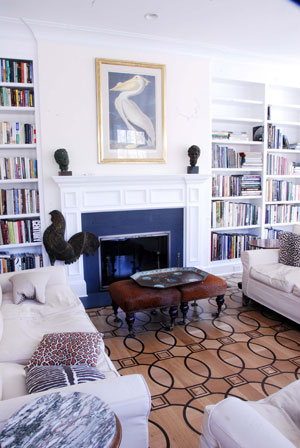 This focus on nontoxic finishes and recycled materials is one of the reasons John was pleased to do the floor for the Mount Kisco, New York, home of Robert F. Kennedy Jr. and the late Mary Kennedy after it had experienced a mold infestation. The Kennedys, he said, “were militant about about toxicity being zero. They were amazing.” Speaking about why he does what he does, John spoke about taking two World War II vets to lunch at a club a few years ago. One veteran, he said, was retired from General Motors; the other had been a framer. As they were driving to the club and passed by several barns on the way, “The one who was a framer kept saying things like, ‘I did that barn in ’47.’ When we got to the club, the other one said, ‘I worked at GM for 50 years, and I can’t show you one thing that I did.'” “In the end, when I’m gone,” John said, “I want something here that I created.”
This focus on nontoxic finishes and recycled materials is one of the reasons John was pleased to do the floor for the Mount Kisco, New York, home of Robert F. Kennedy Jr. and the late Mary Kennedy after it had experienced a mold infestation. The Kennedys, he said, “were militant about about toxicity being zero. They were amazing.” Speaking about why he does what he does, John spoke about taking two World War II vets to lunch at a club a few years ago. One veteran, he said, was retired from General Motors; the other had been a framer. As they were driving to the club and passed by several barns on the way, “The one who was a framer kept saying things like, ‘I did that barn in ’47.’ When we got to the club, the other one said, ‘I worked at GM for 50 years, and I can’t show you one thing that I did.'” “In the end, when I’m gone,” John said, “I want something here that I created.”





